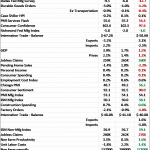Last June, 2017, Senior Deputy Governor of the Bank of Canada (BoC) Carolyn A. Wilkins stepped onto the stage with a surprisingly bullish message about the Canadian economy. This speech set the stage for the BoC’s rollback of “emergency measure” rate cuts that responded to the collapse in oil prices. At the time, the Canadian dollar strengthened swiftly and sent USD/CAD from around 1.345 to 1.33. USD/CAD trended downward for three more months as markets adjusted to rising rate expectations. USD/CAD bottomed at that time around 1.21.
Since then, currency markets have swung wildly between hawkish and dovish interpretations of economic data and the Bank of Canada’s signals and speeches. The BoC’s latest Monetary Policy Report (MPR) was the perfect expression of this swirl of cautious optimism about the path forward. The report contained good news and bad news; net-net, traders decided to sell the Canadian dollar in what I suspect was disappointment in hearing anything that suggested the BoC is ready to resume rate hikes any time soon. This weakness, overlaid with the recent strength in the U.S. dollar, caused USD/CAD to rebound from the borderline of a breakdown below its 200-day moving average (DMA) to a challenge of its 50DMA.

Source: TradingView.com
It is starting to look like higher lows and higher highs for USD/CAD as the Bank of Canada motivates fresh selling in the Canadian dollar.
The BoC today left its target for its overnight rate at 1¼%. The Bank Rate is 1½% and the deposit rate is 1%. More importantly, the BoC made it clear it is too worried about downside risks to get serious about mapping out a path to higher rates as, for example, the U.S. Federal Reserve has done. This clarity only came after a question during the press conference: a member of the press directly told Governor Stephen S. Poloz and Wilkins that the message in the MPR is not clear. She asked them to sum up the future of monetary policy. Here is Poloz’s response paraphrased (emphasis mine):












Leave A Comment